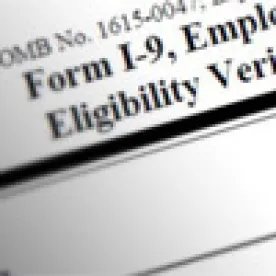USCIS has begun issuing I-797A, Notice of Action Approval Notices containing inconsistent validity periods on the face of the document. Specifically, the top portion of the I-797A approval notices lists the approved visa classification (e.g., H-1B) and the authorized validity period of that visa classification (e.g., from Oct. 1, 2017, to Sept. 11, 2020). The bottom portion of the approval notice, containing Form I-94, Arrival-Departure Records, now lists different validity periods – generally an additional 10 days of validity in comparison to the validity dates listed on the top of the approval notice (e.g., from Oct. 1, 2017, to Sept. 21, 2020). This change in the approval notices is causing confusion for both employers and employees.
Ability to stay in the United States vs. Ability to Work in the United States
USCIS is printing different dates on the top and bottom of the approval notice in order to convey information on different topics. The validity dates on the top portion of the approval notice reflect the dates the individual is allowed to work in the United States. The validity dates on the bottom portion of the approval notice reflect the dates the individual is allowed to stay in the United States.
USCIS’s change to the approval notices corresponds to the language in 8 CFR 214.1(l)(1), which states: “An alien admissible in E-1, E-2, E-3, H-1B, L-1, or TN classification and his or her dependents may be admitted to the United States or otherwise provided such status for the validity period of the petition . . . plus an additional period of up to 10 days before the validity period begins and 10 days after the validity period ends. Unless authorized under 8CFR 274a.12, the alien may not work except during the validity period.” This grace period is a period of authorized stay but does not provide the beneficiary authorization to work beyond the petition validity period.” This information also appears in the top portion of the approval notice, which states: “The I-94 attached below may contain a grace period of up to 10 days before, and up to 10 days after the petition validity period for the following classifications: CW-1, E-1, E-2, E-3, H-1B, H-2B, H-3, L-1A, L-1B, O-1, O-2, P-1, P-2, P-3, TN-1, and TN-2…This grace period is a period of authorized stay but does not provide the beneficiary authorization to work beyond the petition validity period.”
Takeaways for Employers in Light of USCIS’s Updated Approval Notices
The updated USCIS approval notices advise the employer to keep the upper portion of the approval notice and provide the lower detachable portion (containing Form I-94) to the employee. The updated approval notice also states that the employee should keep the right part (Form I-94) with his or her Form I-94, Arrival-Departure Record. If an employer follows this guidance and only provides the employee with the bottom portion of the approval notice, then the employee will only have knowledge of the expiration date listed on his or her I-94 and will not have knowledge of the potentially different dates on the top portion of the notice that control the employee’s dates of employment authorization. In order to avoid confusion, in addition to providing employees with the original lower detachable portion of the approval notice (containing Form I-94), employers can also provide employees with a photocopy of the complete approval notice containing both the top and bottom portions.
The inclusion of a 10 day grace period on the bottom portion of the updated approval notices can create confusion for employers when completing Form I-9. Form I-9 is used for verifying the identity and employment of authorization of employees hired in the United States. All U.S. employers must complete Form I-9 for each employee hired on or after Nov. 6, 1986.
Section 1 of Form I-9 requires the employee to attest, under penalty of perjury, their current immigration status and expiration of such status, if applicable. Employees working pursuant to a nonimmigrant work authorized status must select box 4 “An alien authorized to work until (expiration date, if applicable, mm/dd/yyyy)” and provide the expiration of such authorization in the line provided in Section 1. If the employee is completing Section 1 with the information listed on the detachable Form I-94 from a recently issued approval notice, the employee could incorrectly list an employment authorization date 10 days beyond the expiration of their actual work authorization date. As such, it is important for employers to provide employees with a full copy of their approval notice, in addition to the original copy of the detachable I-94. Providing a full copy of the approval notice to the foreign national employee enables the employee to properly complete Section 1, listing the actual end date of the employment authorization (as opposed to the end date of their authorized stay as listed on their detachable I-94).
Section 2 of Form I-9 requires the employer to verify the identity and work authorization of the employee. A nonimmigrant alien authorized to work may present a foreign passport and Form I-94 as a List A document to demonstrate identity and employment authorization. Employers must be aware that an employee may provide a Form I-94 that contains a validity date that exceeds the date of authorized employment as reflected on the top portion of the I-797A approval notice. The current version of the USCIS publication M-274, Guidance for Completing Form I-9 (Employment Eligibility Verification Form), which provides guidance on the proper completion of Form I-9, states that when completing Section 2 the employer representative must copy the requisite information exactly as provided on the presented documents. Specifically, the employer representative must enter the “document title, issuing authority, number(s) and expiration date (if any) from the original document(s).” If an employee presents a foreign passport and a detachable Form I-94 as a List A document, the employer representative should list the expiration date exactly as listed on the detachable Form I-94 in Section 2, not the dates from the top portion of the I-797 approval notice. A similar practice should be followed when performing re-verification in Section 3 of the Form I-9.
It is helpful for the employer representative to review the company copy of the approval notice to compare the detachable Form I-94 expiration date to the approval notice expiration date. If the detachable Form I-94 includes an additional 10 days of authorized stay, the employer representative can create a reminder for the company to re-verify the employee’s employment authorization documents prior to the expiration date listed on the top portion of the approval notice, not the expiration date listed on the detachable Form I-94 presented by the employee.
Upon completing Form I-9, the employer representative should store a copy of the full I-797A approval notice with the I-9, or store the copy of the approval notice in a readily available location so that in the event of an ICE audit the employer can provide a copy of the full approval notice to ICE to demonstrate that the Form I-9 has been completed correctly, despite the discrepancy between the employment authorization end date listed in Section 1 by the employee and the end date listed in Section 2 by the employer representative.




 />i
/>i

